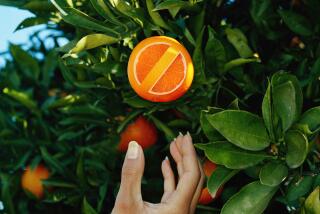Gardening : Thin Fruit Early for Good Results : Trees: Most important chore in the home orchard pays off.
- Share via
If you have a peach or a plum or other deciduous fruit tree in your back yard and you aren’t thinning the fruit, the quality produced will be quite inferior to what it could produce if properly thinned.
According to fruit tree expert Bill Nelson at Pacific Tree Farms in Chula Vista, one of the largest home orchard nurseries in California, fruit thinning is one of the most important chores in the home orchard; it must be done religiously.
Nelson says that to get the large, succulent fruit a home-grown tree is capable of producing, you must thin the fruit each spring when the fruit is about the size of a dime. In addition to improving the size and quality of the remaining fruit, thinning helps prevent branches from getting overloaded and breaking.
It is especially crucial to thin the fruit of young deciduous trees. Nelson says the fruiting process is an energy-reducing feature in new or young trees. By thinning the fruit, you can channel more of the tree’s energies into foliage production and root development. Foliage production is particularly important, Nelson says. The more foliage there is, the more of the sun’s energy can be used by the young trees in their growth process.
Which deciduous fruit trees need thinning? In general, Nelson says, all deciduous fruit trees benefit from the thinning process. These include apple, apricot, fig, nectarine, peach, pear, persimmon, plum and quince trees. Cherry trees are not mentioned because the fruit is so small that thinning is impractical. Additionally, grape vines benefit from thinning.
Nelson says that it is important to note that some natural thinning occurs in most deciduous fruit trees. This process is called “fruit drop.” In some years, when the crop is light, and considerable fruit drop occurs, only a light thinning is necessary.
When and how do you thin the fruit? Nelson recommends that you thin after the natural fruit drop occurs and when the fruit is approximately the size of a dime. To thin, you simply pick the fruit from the branches until each fruit is spaced a certain distance apart. As to that distance, Nelson says that if you want large fruit, you thin the way the commercial growers do, so that the fruit is four to five inches apart. If you are satisfied with medium-sized fruit, two to three inches apart is fine.
Nelson says that in thinning grape vines, you will get larger clusters of fruit by simply removing every second or third bunch just after the bunches have formed.
Although the thinning of smaller fruit trees is a fairly simple process, when the tree grows to 20 feet or so, the task becomes more difficult. It often requires a ladder and becomes a dangerous venture.
Instead of trying to thin from a ladder, Nelson recommends that you construct a thinning device like the commercial growers use. The device is simply a large pole (3/4-inch dowling works fine). the tip of which has been sharpened slightly on two sides for a blunt chisel-like effect. On these two sides you tack on two strips from an old tire. The strips should be 3/4 of an inch wide and should extend 3 inches from the tip of the pole. The strips should resemble two fingers that are spread apart.
With this device you simply reach the pole up into the higher branches, insert the fruit into the rubber fingers and snap it off. This saves possible damage to yourself from a fall from a ladder. It also prevents damage to the tree, as the branches are only minimally disturbed.
What about subtropical fruit trees such as citrus and avocados? Nelson says that except for newly planted subtropicals, fruit thinning is not necessary. However, Nelson notes that if the tree has set a huge crop, some thinning will improve the size of the fruit.
Nelson says that if you are a beginning gardener, it is often emotionally difficult to remove some of the very first fruit you have actually grown yourself. But to grow quality fruit, you must force yourself to do it--be ruthless about it.






